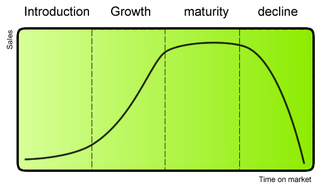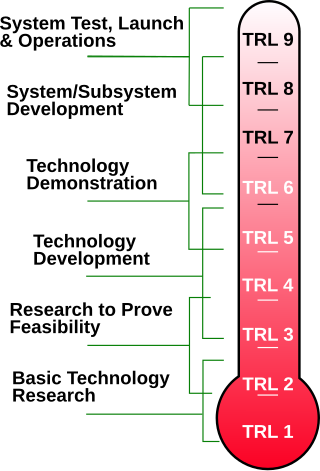Material requirements planning (MRP) is a production planning, scheduling, and inventory control system used to manage manufacturing processes. Most MRP systems are software-based, but it is possible to conduct MRP by hand as well.

Product life-cycle management (PLM) is the succession of strategies by business management as a product goes through its life-cycle. The conditions in which a product is sold changes over time and must be managed as it moves through its succession of stages.
Obsolescence is the process of becoming antiquated, out of date, old-fashioned, no longer in general use, or no longer useful, or the condition of being in such a state. When used in a biological sense, it means imperfect or rudimentary when compared with the corresponding part of other organisms. The international standard IEC 62402:2019 Obsolescence Management defines obsolescence as the "transition from available to unavailable from the manufacturer in accordance with the original specification".

Value engineering (VE) is a systematic analysis of the functions of various components and materials to lower the cost of goods, products and services with a tolerable loss of performance or functionality. Value, as defined, is the ratio of function to cost. Value can therefore be manipulated by either improving the function or reducing the cost. It is a primary tenet of value engineering that basic functions be preserved and not be reduced as a consequence of pursuing value improvements. The term "value management" is sometimes used as a synonym of "value engineering", and both promote the planning and delivery of projects with improved performance.
In economics and industrial design, planned obsolescence is the concept of policies planning or designing a product with an artificially limited useful life or a purposely frail design, so that it becomes obsolete after a certain predetermined period of time upon which it decrementally functions or suddenly ceases to function, or might be perceived as unfashionable. The rationale behind this strategy is to generate long-term sales volume by reducing the time between repeat purchases. It is the deliberate shortening of the lifespan of a product to force people to purchase functional replacements.
Total cost of ownership (TCO) is a financial estimate intended to help buyers and owners determine the direct and indirect costs of a product or service. It is a management accounting concept that can be used in full cost accounting or even ecological economics where it includes social costs.

In systems engineering, information systems and software engineering, the systems development life cycle (SDLC), also referred to as the application development life cycle, is a process for planning, creating, testing, and deploying an information system. The SDLC concept applies to a range of hardware and software configurations, as a system can be composed of hardware only, software only, or a combination of both. There are usually six stages in this cycle: requirement analysis, design, development and testing, implementation, documentation, and evaluation.

In industry, product lifecycle management (PLM) is the process of managing the entire lifecycle of a product from its inception through the engineering, design and manufacture, as well as the service and disposal of manufactured products. PLM integrates people, data, processes, and business systems and provides a product information backbone for companies and their extended enterprises.
Purchasing is the procurement process a business or organization uses to acquire goods or services to accomplish its goals. Although there are several organizations that attempt to set standards in the purchasing process, processes can vary greatly between organizations.
Reliability engineering is a sub-discipline of systems engineering that emphasizes the ability of equipment to function without failure. Reliability is defined as the probability that a product, system, or service will perform its intended function adequately for a specified period of time, OR will operate in a defined environment without failure. Reliability is closely related to availability, which is typically described as the ability of a component or system to function at a specified moment or interval of time.
Design for excellence is a term and abbreviation used interchangeably in the existing literature, where the X in design for X is a variable which can have one of many possible values. In many fields X may represent several traits or features including: manufacturability, power, variability, cost, yield, or reliability. This gives rise to the terms design for manufacturability, design for inspection (DFI), design for variability (DfV), design for cost (DfC). Similarly, other disciplines may associate other traits, attributes, or objectives for X.
Integrated logistics support (ILS) is a technology in the system engineering to lower a product life cycle cost and decrease demand for logistics by the maintenance system optimization to ease the product support. Although originally developed for military purposes, it is also widely used in commercial customer service organisations.
Electronic packaging is the design and production of enclosures for electronic devices ranging from individual semiconductor devices up to complete systems such as a mainframe computer. Packaging of an electronic system must consider protection from mechanical damage, cooling, radio frequency noise emission and electrostatic discharge. Product safety standards may dictate particular features of a consumer product, for example, external case temperature or grounding of exposed metal parts. Prototypes and industrial equipment made in small quantities may use standardized commercially available enclosures such as card cages or prefabricated boxes. Mass-market consumer devices may have highly specialized packaging to increase consumer appeal. Electronic packaging is a major discipline within the field of mechanical engineering.
The Product Life Cycle Theory is an economic theory that was developed by Raymond Vernon in response to the failure of the Heckscher–Ohlin model to explain the observed pattern of international trade. The theory suggests that early in a product's life-cycle all the parts and labor associated with that product come from the area where it was invented. After the product becomes adopted and used in the world markets, production gradually moves away from the point of origin. In some situations, the product becomes an item that is imported by its original country of invention. A commonly used example of this is the invention, growth and production of the personal computer with respect to the United States.

The technology life cycle (TLC) describes the commercial gain of a product through the expense of research and development phase, and the financial return during its "vital life". Some technologies, such as steel, paper or cement manufacturing, have a long lifespan while in other cases, such as electronic or pharmaceutical products, the lifespan may be quite short.
An independent test organization is an organization, person, or company that tests products, materials, software, etc. according to agreed requirements. The test organization can be affiliated with the government or universities or can be an independent testing laboratory. They are independent because they are not affiliated with the producer nor the user of the item being tested: no commercial bias is present. These "contract testing" facilities are sometimes called "third party" testing or evaluation facilities.
The manufacturing readiness level (MRL) is a measure to assess the maturity of manufacturing readiness, similar to how technology readiness levels (TRL) are used for technology readiness. They can be used in general industry assessments, or for more specific application in assessing capabilities of possible suppliers.
Technical Integrity Engineering, also known as Asset Integrity, involves various engineering disciplines that focus on ensuring a product, process, or system meets its intended requirements when used. Applying these disciplines to reduce costs, maintain schedules, manage technical risks, and handle legal concerns during a project's entire life cycle ensures operational safety and efficiency in e.g., Oil and Gas, Power Generation, and Nuclear Power industries.
S4000P - International specification for developing and continuously improving preventive maintenance is a specification developed jointly by a multinational team from the AeroSpace and Defence Industries Association of Europe (ASD) and Aerospace Industries Association (AIA). S4000P is part of the S-Series of ILS specifications and is integrated in the global ILS process defined by SX000i - International guide for the use of the S-Series of Integrated Logistics Support (ILS) specifications.

Technology readiness levels (TRLs) are a method for estimating the maturity of technologies during the acquisition phase of a program. TRLs enable consistent and uniform discussions of technical maturity across different types of technology. TRL is determined during a technology readiness assessment (TRA) that examines program concepts, technology requirements, and demonstrated technology capabilities. TRLs are based on a scale from 1 to 9 with 9 being the most mature technology.





